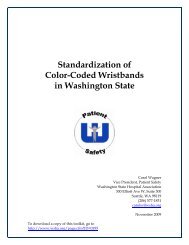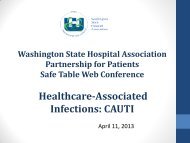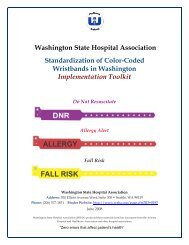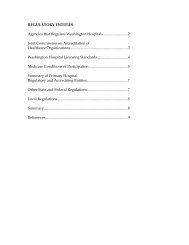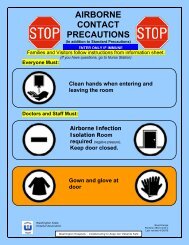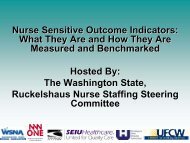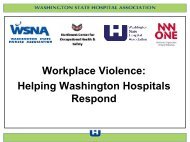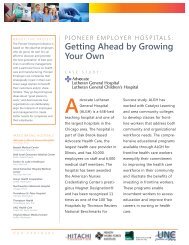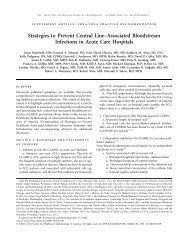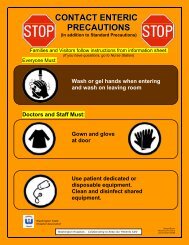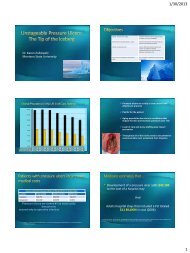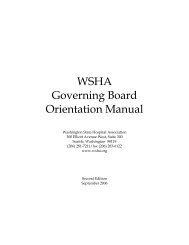Potentially Avoidable Emergency Room Use - Washington State ...
Potentially Avoidable Emergency Room Use - Washington State ...
Potentially Avoidable Emergency Room Use - Washington State ...
- No tags were found...
You also want an ePaper? Increase the reach of your titles
YUMPU automatically turns print PDFs into web optimized ePapers that Google loves.
WSHA ER ReportFrequency and costWhen the 2.6 million visits in the study data set were reviewed for all potentially avoidable conditionsclassified under the Medi-Cal approach, avoidable visits accounted for 11.4 percent of the visits and 3.5 percentof charges ($477.8 million). <strong>Potentially</strong> avoidable conditions are largely of low clinical severity with a relativelylow average charge for these visits − roughly $1,600 compared with the $5,363 average for all visits in theoriginal study.Even so, these visits increase overall health care expenditures because emergency room care costs far moreto deliver than treatment in an office or clinic setting. Moreover, when one out of nine visits is avoidable, thereis a perceptible impact on ER capacity; it can make the difference between an overcrowded emergency roomor simply a busy one. More difficult to quantify is the potential for improving outcomes and long-term patienthealth with appropriate care that goes beyond treating the symptoms presented in the ER. 4<strong>Emergency</strong> <strong>Room</strong> Charges of 53 <strong>Washington</strong> Hospitals, January 2008 - June 2009While not included in the potentially avoidable visits, the report also looked at ER visits for dental andmental health care. Dental care accounted for 2.0 percent of all ER visits and 0.3 percent of all ER charges($36.3 million). Mental health services were the primary diagnoses in 4.5 percent of ER cases and represented3.9 percent of all ER charges ($532.2 million) in the study population.While potentially avoidable use of hospital ERs is a contributing factor to the increasing cost of health care, itsoverall cost impact is relatively minor when compared to other medical cost drivers. The costs of programs toreduce this inappropriate use need to be examined carefully to ensure their cost effectiveness.4 These numbers do not include visits for mental and dental conditions, which are discussed separately.February 2011 4
WSHA ER ReportTime of Day and Day of Week:• Time of day and day of week patterns for avoidable visits and all ER visits are very similar, virtuallyidentical for time of day. Visits are most likely to occur between noon and 8:00 p.m. and least likelyovernight.• <strong>Avoidable</strong> visits are more likely to occur on the weekend, when most primary care providers are notavailable.In the following graphs, “All ER Visits” are displayed as 1/10 of their actual counts to allow for comparisonof visit patterns with avoidables.<strong>Avoidable</strong> and All ER Visits by Time of Day<strong>Avoidable</strong> and All ER Visits by Day of WeekFebruary 2011 7
WSHA ER ReportMost common reasons for apotentially avoidable ER visitEighty-seven percent of all potentially avoidable visits in the study were accounted for by 10 primary diagnosiscodes. These same 10 also appear among the top 50 most frequent primary diagnoses in WSHA’s emergencyroom study (not including dental or mental health services). The potentially avoidable diagnoses are:• Acute upper respiratory infection• Headache• Urinary tract infection• Otitis media (ear infection) (two separatediagnosis codes)• Back pain (two separate diagnosis codes)• Acute throat inflammation• Acute bronchitis• Issuance of a repeat prescriptionThese eight conditions comprise nearly 10 percent of all ER visits in the study, but only 3.2 percent of ER charges.Some key findings about these visits are:By Payer Segment:• For Medicaid patients, acute upper respiratory infection (57 percent) closely followed by ear infection (55percent for both Otitis media diagnoses) were the highest incidence diagnoses. This is likely due to theyounger average age of this population.• For Medicare patients, acute urinary tract infection was the most prevalent diagnosis, at 33 percent.• For private insurance patients, headaches represented 40 percent of avoidable visits.By Gender:• The same gender gap is seen in the avoidable diagnosis subset as the complete set of all ER visits (60percent female versus 40 percent male) than in total ER visits (54 percent female versus 46 percent male).• Males outnumber females for only three avoidable diagnoses: issuance of repeat prescription (58 percent),and the two ear infection diagnoses (51 percent each).By Diagnosis of Headache, UTI, and EaracheWithin a specific primary diagnosis, that data shows that there can be a wide range of cases that vary by diagnosticmethods, severity of illness, and treatment – and also by hospital charges. Three diagnoses are explored in thissection: headache, urinary tract infection, and earache.5While headache is a potentially avoidable diagnosis, all headaches may not be the same. Data from <strong>Washington</strong>hospitals included visits with bills ranging from a few hundred dollars to tens of thousands of dollars. Furtheranalysis of the secondary diagnoses, however, revealed little difference among the diagnoses between the lowestcharge group and the higher charge group. It could be that the higher cost headache cases were due to “sicker” patientswith more complicated conditions, but it is difficult to know from the limited administrative data available.5 The diagnosis codes used in this section are: headache (594.0), urinary tract infection (599.0), and earache (both otitis media, 382.9,and acute supperative otitis media, 382.0).February 2011 8
WSHA ER ReportBy Diagnosis (continued)Some of the variation in charges is due to differences in services provided. Far less than one percent of theheadache visits with charges under $1,000 included any diagnostic radiological services. Sixty percent ofthe patients with charges of more than $1,000, however, had some type of radiology service (CT scan, MRI,X-ray). This suggests that at least half of these cases presented with a headache could have been a symptom of amore serious diagnosis, triggering more extensive testing. Rulingout serious causes of headache is an important medical practice.In the end, more serious diagnoses were not supported. It isimportant to remember, however, in many cases there is likely noway of knowing this is the case when these patients walk into theER.Similar variation in services was also observed in patients withUTI. More radiology services and higher charges were incurredfor adults 18 to 64 than for children, and the highest averagecharges and most radiology tend to be for those 65 and older.Patient visits for earache are often used as an example of avoidable emergency room use (although they accountfor just 1.4 percent of all ER visits and only 0.2 percent of all ER charges). As expected, 65 percent of otitismedia cases are children under the age of six, and another 12.5 percent are between the ages of six through ten.Because otitis media is often considered a clear-cut primary care condition that should not show up in the ER, itis useful to compare when these cases are brought to the ER.Regardless of insurancecoverage, earache visitsoccur at the same times,and this pattern is somewhatdifferent from the overall ERtime pattern: relatively fewerearache cases during theday time, and significantlymore in the evening, startingfrom 6 p.m. until midnight,and continuing through thenight. Because earaches areusually accompanied by feversand uncontrolled crying,parents are often advised toseek care when they occur atnight – and the ER is their onlyresource. The charges for thesevisits are relatively low, at justover $500.ER Visits for Otitis Media (OM) Primary Diagnosis by Time of Day“All ER Visits” are displayed as 1/10 of their actual counts to allow for comparison of visitpatterns with avoidablesFebruary 2011 9
WSHA ER ReportDental care in the ERThis section provides a deeper exploration of dental health care delivered in emergency rooms across<strong>Washington</strong> <strong>State</strong>. As explained in the introduction, diagnoses in this category are not considered potentiallyavoidable. They are, however, topics of great interest when discussing ER utilization. This section is by nomeans an exhaustive exploration of dental care, but rather presents a few interesting fi ndings.Dental Dx as Percent of ER visitsWestern WA 2.12Eastern WA 1.90Urban 2.09Rural 1.86WSHA identified 74 diagnoses (see Appendix for acomplete list) that appear to be related to lack of accessto dental care. Patients come to the ER for pain relief fromcavities, broken teeth, and abscessed roots. Usually the onlytreatment that can be provided is a painkiller and a referralto a community dental clinic. Consequently, the averagecharge for a dental ER visit is $669, far less than the$1,601 average charge for avoidable diagnoses. While individual dental ER visits stand out as examples ofinappropriate use, as a category they account for only two percent of all ER visits, and for significantly less than1 percent (0.3) percent of all ER charges. The rate of incidence shows little difference by geography (east/west),or by community size (urban/ rural).The three most frequent dental primary diagnoses account for 80 percent of all dental visits, and 75 percent ofall dental charges:• Dental disorder (not otherwise specified), 43 percent of visits• Periapical (root) abscess, 24 percent• Dental caries (cavity), not otherwise specified, 13 percentER visits for dental care are typically made by adults, with 93 percent of visits made by someone who is at least18 years old. Dental visits make up 4 percent of ER visits by young adults 18 to 30.Medicaid recipients and the uninsured accountfor two-thirds of all ER dental visits. Whilethe number of cases is relatively small, thisfinding suggests an access problem for thesepopulations. The shortage of dentists whowill take Medicaid patients, due to lowreimbursement, is widely noted.Dental ER Visits by PayerFor the uninsured who come to the ER,affordable dental care is probably not anoption. Five percent of all ER visits made bythe uninsured are for dental diagnoses. “Dentaldisorder otherwise unspecified” is the mostfrequent primary diagnosis of all the uninsuredER visits, comprising two percent of their visits.The proportion of ER dental patients who have private health coverage is surprisingly high at 16 percent. Oneout of six ER dental patients with some financial stability, evidenced by employment and health insurance,apparently do not access routine dental care. Having health insurance does not necessarily mean a person hasdental coverage or a dental provider.February 2011 10
Mental health in the ERWSHA ER ReportThis section provides a deeper exploration of mental health care delivered in ERs across <strong>Washington</strong> <strong>State</strong>.As explained in the introduction, diagnoses in this category are not considered potentially avoidable.Theyare, however, topics of great interest when discussing ER utilization. This section is by no means an exhaustiveexploration of mental care, but rather presents a few interesting fi ndings.Psychiatric and substance abuse cases brought to the emergency room are a particular focus of concern forhealth care organizations. They are usually life-threatening and require immediate care. They provide dramaticand frustrating evidence of the seriously broken mental health system. The incidence of such cases varies fromhospital to hospital, but overall, they comprise 4.5 percent of all ER visits, much less than the list of otheravoidable visits at 11.4 percent. However, because the average charge for each mental health visit is so muchhigher ($4,487, compared to $1,601), the financial impact is larger – 3.9 percent of all ER charges, compared tothe 3.5 percent of all avoidables share. (See Appendix 2 for a complete list of mental health and substance abusediagnoses used in this analysis.)The ER mental health patient population has amix of insurance coverage similar to that foundin the avoidable or dental visit data. Medicaidis the largest segment in frequency (30 percent),followed by private pay (26 percent). Medicareis in third place with an 18 percent share,closely followed by the uninsured at 16 percent.Psych/Substance Abuse ER Visits by PayerMental health visits differ from the avoidablesgroup in age and gender. More than 90 percentof mental health ER visits are made by adultsage 18 and older, in contrast with the largeravoidables population in which just under 65percent of visits are by adults.In contrast to the potentially avoidable visits,which are 60 percent female, the mental healthvisits are evenly divided between male andfemale patients. The gender split shifts whenthe psychiatric disorder visits are separatedfrom substance abuse ones. The psychiatric subset is the larger of the two components explored in this section,with 62 percent. A slight majority of these visits, 53.5 percent, are made by females. This gender gap is reversedin the substance abuse subset where male patients make 57 percent of the visits.February 2011 11
WSHA ER ReportWhy are people seeking potentiallyavoidable care in the ER?One national study of emergency room use found long wait times for physician offices increased ER visitswhile greater community health capacity led to a reduction in ER visits for poor and low-income people.6The same study found that more care management resulted in lower ER utilization. As will be discussed in thenext section of this paper, some <strong>Washington</strong> health care organizations have successfully used this approach withpatients who have a higher frequency of ER visits.7Another national report noted among the reasons people use the ER were:• People truly think that they have an emergency• An individual may not have access to primary care or cannot get into the office in a timely manner• Primary care was not open when they needed it or they could notaccess it• Some individuals do not realize that they have options outside theER.Several studies have noted the impact on avoidable ER use from high utilizersor “frequent fliers.” These are people who repeatedly seek care in theER for a variety of reasons from chronic conditions to mental illness or drugseeking behavior. Since the data set contained no information to identifyindividual patients, this issue could not be addressed using this data set. Inone study 40 percent of responding hospitals cited this population as linked8to avoidable ER use. The study also noted that, for the 40 percent, the mostcommon conditions were: chemical dependency (20 percent), mental health (10 percent), pain management (20percent) and medication non-adherence (20 percent).9In 2007, a report from a <strong>Washington</strong> <strong>State</strong> task force study on strategies to reduce unnecessary emergencyroom use outlined a list of complex issues driving use patterns. Reasons noted in the report include:• Lack of primary care providers, or access to these providers• Decisions by the patient to seek more immediate care rather than wait to visit their physician• Patients with mental illness and patients with substance abuse issues use the ER as their medical home• Lack of incentives for primary care health delivery• Lack of disincentives to use ER services for non-emergent conditions6 Cunningham, Peter J. What Accounts for Differences in The <strong>Use</strong> of Hospital <strong>Emergency</strong> Departments Across U.S. Communities?Health Affairs. Web Exclusive. July 2006.7 27 Interventions to Reduce <strong>Avoidable</strong> ER <strong>Use</strong>. Tactics to Manage Non-Urgent Cases, High Utilizers, and Special Populations. TheHealth Care Intelligence Network. November 2010.8 2010 Performance Benchmarks in Reducing <strong>Avoidable</strong> ER Visits. The Health Care Intelligence Network. 2010.9 ESSB 5930 Report: Reducing Unnecessary <strong>Emergency</strong> <strong>Room</strong> <strong>Use</strong>. Presentation to the <strong>Washington</strong> <strong>State</strong> House Health Care & nWellness Committee,February 2011 12
WSHA ER ReportThe solutionsMany hospitals across <strong>Washington</strong> <strong>State</strong> are working on solutions to address avoidable ER visits. WSHA isworking with payers to incentivize collaborations within the health care community to reduce unnecessary ERuse. This section provides a few examples of the work hospitals are already undertaking.Preventing Drug Seeking BehaviorAccording to the Centers for Disease Control and Prevention,the number of ER visits involving patients who were seeking aprescription for a narcotic for a non-medical reason more thandoubled in the United <strong>State</strong>s between 2004 and 2008. Hospitalsacross <strong>Washington</strong> <strong>State</strong> are working to prevent drug seekingpatients from feeding their habits in emergency rooms.One effective strategy is to limitthe prescription pain medications,especially opioids, prescribedthrough the emergency rooms.One effective strategy is to limit the prescription pain medications, especially opioids, prescribed through theemergency rooms. Several hospitals across <strong>Washington</strong> <strong>State</strong> are working to ensure individuals withdrug addiction know the emergency room is not a source for narcotics. A number have become “Oxy-free.”Physicians working in these ERs will not give out prescriptions for Schedule II drugs, a group including10OxyContin and Percocet.Other hospitals are tracking patients who frequently visitemergency rooms for drugs. Hospitals in Skagit County aretaking a coordinated approach to treating individuals feeding adrug addiction who do not need medical care. When a patientmakes a repeat visit to any hospital in the area seeking painmedications, the patient is counseled on more appropriateoptions for care and informed that the emergency room will notbe providing prescriptions. The patient is then asked to sign aform acknowledging receipt of the information.“They hear the same thing from all the hospitals in the area and get the message,” said Donna McCabe, RN,Director of <strong>Emergency</strong> Services at Skagit Valley Hospital.Another example is in Spokane, where hospitals are using a computer database created and hosted by the<strong>Washington</strong> <strong>State</strong> Department of Health called the <strong>Emergency</strong> Department Information Exchange. Throughthe database, hospitals flag patients who frequently visit the ER and include information about the patient’sprimary care provider and care plan. The information is then available to any other hospital using the system.Hospitals report that these strategies have significantly reduced visits by patients seeking opioid prescriptions.Nearly 20 additional hospitals from across the state are currently in the process of joining the informationexchange network.10 Seattle Times “New state pain-medication law has doctors and patients nervous”. http://o.seattletimes.nwsource.com/html/localnews/2012873602_drugs12m.html Accessed January 18, 2011.February 2011 13
WSHA ER ReportBetter Coordinated CareMany visits to the emergency room could be avoided by providing care in a more appropriate setting. Insome cases the ailment is non-emergent; in others the visit could have been avoided if a condition had beenaddressed by a primary care provider before it became emergent. In some cases patients end up in theemergency room because they have not been able to get primary care. Several communities are addressing thisissue by coordinating care among physicians, hospital emergency rooms, and community clinics to targetedpatient populations with chronic access issues. The communities are tackling the issue of inappropriate carethrough care coordination, patient education, and the use of technology. Here are a few examples:In 2003, Providence St. Peter Hospital in Olympia partnered with CHOICE regional health network to connectfrequent ER visitors with appropriate primary care services. Since its inception, four additional hospitals havejoined the <strong>Emergency</strong> Department Consistent Care Program: Capital Medical Center, Grays Harbor CommunityHospital, Mark Reed Health Care District, and Providence Centralia Hospital.Those who voluntarilyjoined the programreduced their visits tothe ER by 58 percent.After two visits in a month or four visits in six months, the charts for thesepatients are flagged. This triggers a RN care coordinator evaluation of theircase for chronic health problems, mental illness, and/or drug addiction. Thepatient is then invited to participate in a program to provide more coordinatedcare. Once the patient is accepted for intervention, a multi-disciplinary teamreviews the case and an individual care plan is developed.About 11 percent of the patients identified elect to accept the help. Theprogram, however, tracks visits of all flagged patients. Contacting these patients and flagging their recordshas been effective in reducing visits by patients only seeking medications. Those who voluntarily joined theprogram reduced their visits to the ER by 58 percent, while patients who were referred and did not accept had11a 43 percent reduction in visits.Four years ago, Spokane hospitals also began working to coordinate care for frequent emergency room visitors.The model they adopted is very similar to that developed at Providence St. Peter’s. Using the statewide<strong>Emergency</strong> Department Information Exchange, hospitals record care plans for patients and these plans areaccessible to any other ER connected to the system. Each hospital uses an RN care coordinator to manage theprogram. Across the entire Spokane area, ER visits for enrolled patients are down 56 percent.“Ninety to 95 percent of the patients referred to the program respond well,” said emergency physician Dr. DarinNeven. “A lot of these patients are dealing with concurrent health issues. This program connects them to tools totake care of themselves so they don’t end up in the ER.”In the past year, Providence Regional Medical Center Everett also adopted the same model to reduce avoidableER visits. <strong>Emergency</strong> room leaders point out an additional benefit to the program: increased staff satisfaction.“ER staff love it because they know these patients and they know that the ER is not the appropriate place forthem to receive care,” said Julie Zarn, RN, Director of <strong>Emergency</strong>/Trauma in Everett. “They love that a systemis finally in place to get these patients the care they need.”11 <strong>Emergency</strong> Department Consistent Care Program at Providence St. Peter Hospital: An Evaluative Report. Published April 21, 2010.February 2011 14
WSHA ER ReportSimilar work is being done in collaboration with community clinics at four pilot sites in <strong>Washington</strong> –Auburn, Bellingham, Spokane, and Pasco. The <strong>Washington</strong> <strong>State</strong> Department of Social and Health Servicesis conducting this pilot study to determine the effectiveness of programs in reducing potentially avoidable ERvisits using care coordination through community and migrant health centers. All of the sites implemented a24-hour nurse hot line where patients can call to determine the best place to go for care. They are also usingpatient navigators to assist patients with getting health care that is appropriate for their needs. The communityand migrant health centers in the pilot communities have extended their operating hours to make gettingprimary care more convenient.The pilot is also testing the use of public education to change behavior, includingdistributing a book called “What to Do When Your Child is Sick.” The book targetsparents because families with young children are often the highest utilizers of ER servicesthat could be delivered at a clinic.The project based at Lourdes Medical Center in Pasco has taken public education one stepfurther with public service announcements on local radio stations and educational videosplayed at food banks and other outlets where people get social services. Results from thiscommunity clinic and hospital pilot project should be published later this year.Partnerships for Dental CareProvidence Centralia Hospital is tackling potentially avoidable use of theER on several fronts. A year ago, space on the campus was donated for acommunity urgent care clinic, run by a local non-profit. The clinic givespatients an appropriate alternative to the ER in a convenient location.The organization has also developed an effective system for dealingwith patients who come to the ER with a dental complaint. The hospital partneredwith a local federally-qualified community health center thatprovides dental services. Patients who come to the ER with a dentalcomplaint are triaged and then scheduled for an appointment within 24 hoursat the dental clinic. If the patient does not show up for his or her scheduledappointment, the dental clinic notifies the ER and a note is placed in thepatient’s record. If the patient returns, ER staff are able to talk with themabout their missed appointment and explain that the ER is not an appropriatesetting for dental treatment.One outstanding result is the instances of patients seeking pain medicationfor dental cases in the Providence Centralia ER has decreased by 50 percentwithin the last year. Staff believe the system is connecting patients with appropriate care andeliminating visits where tooth pain is used as a path to prescription pain medication.February 2011 15
WSHA ER ReportMultiple Strategies Lead to Lower RatesThe UW Medicine Health System has one of the lowest rates of potentially avoidable emergency room visits inthe state at its Harborview Medical Center, UW Medicine/Northwest Hospital & Medical Center, and Universityof <strong>Washington</strong> Medical Center ERs.For several years, the system has focused on ensuring that patients have access to the appropriate level of care.UW Neighborhood Clinics offer same day appointments and clinics are open from 8 a.m. to 8 p.m. on weekdaysand also have weekend hours.“We have found that convenient same day clinic access reduces lower intensity emergency department visits,”said Johnese Spisso, Chief Health System Officer, UW Medicine and Vice President for Medical Affairs,University of <strong>Washington</strong>.Another strategy the UW system employs is a 24/7 community care nurse advice line. The number is given to allpatients upon discharge from an acute care hospital. The nurse line also answers after-hours calls to clinics.To help patients with drug abuse issues, the UW system implements and follows very specific care plans andoffers access to programs that address addiction. The approach has greatly reduced the number of patientsrequesting narcotics through the ER.Public EducationA recent study states “more and more patients regard the emergency department as an acceptable or even theproper place to go when they get sick and the reality is that the ER is frequently theonly option.” There are many cases where going to the ER is a matter of convenience.For this population, there is an opportunity to provide education about why theemergency room is not the best choice for care. Some communities across thecountry have implemented education programs. For example, North Carolina has implementeda medical home and ER communication initiative to provide families witheducation about the importance of contacting their primary care physician first beforegoing to the emergency room. In Louisville, the EMS system refers ambulance callsfor earaches, stomachaches, or other minor issues to a nurse call line, which helps thepatient find the most appropriate facility for care.The <strong>Washington</strong> <strong>State</strong> Hospital Association is developing a brochure to educatepatients about when to use the ER and how to access more appropriate care if theydo not have a medical emergency. The brochure explains what conditions might bebetter cared for in a primary care or urgent care clinic.Doctor’s Office,Urgent Care Clinic,or the <strong>Emergency</strong> <strong>Room</strong>?A guide tohelp you choosethe best placeto go forhealth care.February 2011 16
WSHA ER ReportConclusionThe findings in this report show that while avoidable ER visits are occurring in hospitals across <strong>Washington</strong><strong>State</strong>, they account for only a small percentage of the cost of care provided in the ER. The report also showsthat, regardless of their insurance status, people go to the ER with ailments that could be treated elsewhere. Inaddition to better access to regular sources of care, education may be needed to change behavior.The findings from this analysis suggest that many potentially avoidable visits may be eliminated if adequateaccess is given to other venues for care. Key points to remember in considering this issue are:• Many potentially avoidable ER visits are related to failures of the payment and delivery systems.With adequate primary care, dental and mental health services widely available and paid for, the use ofERs would be reduced and services could be better provided as a part of coordinated patient care in better,less costly settings.• Directing patients to other alternatives requires patient education and interventions. This canonly be accomplished by all parts of the health care system working on this issue. The acuity of someof these “avoidable” visits appears to indicate that an individual is potentially much sicker than wouldbe assumed based on the primary diagnosis. Some of this may reflect coding issues, and some may berelated to the impact of “defensive medicine.”• Not everyone agrees that these diagnoses are always avoidable. One national report on urinarytract infection patients in the ER, Kaiser Permanente found, “subsets of these patients need to presentbecause there is a possibility of a kidney stone. In general, the guideline states that those members over65 or who have recurrent UTIs really need to be seen, so we’re treating them.”• Hospitals in <strong>Washington</strong> <strong>State</strong> are implementing effective programs to reduce potentiallyavoidable ER visits and directing patients to appropriate care. These successful programs shouldbe replicated in other hospitals.Impact of <strong>State</strong> Budget CutsThe Governor and state legislators are contemplating eliminating orsignificantly cutting back three state health insurance programs ─ BasicHealth, Disability Lifeline, and Apple Health. Making these cuts couldmean as many as 100,000 newly uninsured in <strong>Washington</strong> <strong>State</strong>, virtuallyovernight.These cuts would put significant and immediate pressure on hospital ERs.Many people covered by these programs have significant health problemsand need ongoing care. The ER will be their only source of care. Hospitalscan only address the issues of potentially avoidable ER visits if there arecommunity alternatives where patients will be seen and treated.February 2011 17
WSHA ER ReportImproving Quality. Increasing Access. Serving Members. Since 1933.Special thanks to data analysts Suzie Burton and Thom Rees for their work with the data set. Formore detailed information on any of these topics, please contact the Health Information Programthrough Jim Cannon at jimc@wsha.org or (206) 216-2551 or Jane Feldman at janef@wsha.org or (206)216-2505 .Report AuthorsJim CannonExecutive Director, Health Information Program<strong>Washington</strong> <strong>State</strong> Hospital AssociationJane FeldmanDirector, Analytical Services, Health Information Program<strong>Washington</strong> <strong>State</strong> Hospital AssociationClaudia SandersSenior Vice President, Policy Development<strong>Washington</strong> <strong>State</strong> Hospital AssociationBeth ZborowskiDirector, Program Communications<strong>Washington</strong> <strong>State</strong> Hospital AssociationFebruary 2011 18
Appendix 1WSHA ER ReportMedi-Cal <strong>Avoidable</strong> ICD 9 Diagnosis Codes used in ER studyICD-9CodeDescription1105 Dermatophytosis of body1120 Candidiasis of mouth112 Candidiasis of mouth1121 Candidal vulvovaginitis1122 Candidias urogential NEC1123 Cutaneous candiiasis1128 Candidiasis-other specified sites11282 Candidal otitis external11284 Candidal esophagitis11285 Candidal enteritis11289 Candidiasis site NEC1129 Candidiasis site NOS133 Acariasis1330 Scabies1338 Acariasis NEC1339 Acariasis NOS372 Disorders of conjunctiva3720 Acute conjunctivitis37200 Acute conjunctivitis unspecified37201 Serous conjunctivitis37202 Ac follic conjunctivitis37204 Psudomemb conjunctivitis37205 Ac atopic conjunctivitis37210 Chronic conjunctivitis, unspecified3721 Chronic conjunctivitis37211 Simpl chr conjunctivitis37212 Chr follic conjunctivitis37213 Vernal conjunctivitis37214 Chr allrg conjunctivitis NEC37215 Parasitic conjunctivitis3722 Belpharoconjunctivitis37220 Belpharoconjunctivitis, unspecified37221 Angular blepharoconjunct37222 Contact blepharoconjunct3723 Other and unspecified conjunctivitis37230 Conjunctivitis, unspecified37231 Rosacea conjunctivitisICD-9CodeDescription37239 Conjunctivitis NEC37203 Other mucopurulent conjunctivitis37333 Xeroderma of eyelid382 Suppurative and unspecifiedotitis media38200 Acute suppurative otitis mediawithout spontaneous rupture ofear drum3820 Acute suppurative otitis media38201 Acc supp om w drum rupt3821 Chr tubotympan suppur om3822 Chr atticoantral sup om3823 Chr sup otitis media NOS3824 Suppur otitis media NOS3829 Otitis media NOS38302 Ac mastoiditis-comp NEC460 Acute nasopharyngitis462 Acute pharyngitis4650 Acute laryngopharyngitis465 Acute upper respiratory infectionsof multipl of unspecifiedsites4658 Acute uri mult sites NEC46659 Acute uri NOS4660 Acute bronchitis466 Acute bronchitis and bronchiolitis4720 Chronic rhinitis472 Chronic pharyngitis and nasopharyngitis4721 Chronic pharyngitis4722 Chronic nasopharyngitis4730 Chronic maxillary sinusitis473 Chronic sinusitis4731 Chr frontal sinusitis4732 Chr ethmoidal sinusitis4733 Chr spenoidal sinusitis4738 Chronic sinusitis NEC4739 Chronic sinusitis NOSICD-9CodeDescription4740 Chronic tonsillitis and adenoiditis47400 Chronic tonsillitis474 Chronic disease of tonsils andadenoids47401 Chronic adenoiditis47402 Chronic tonsils and adenoids4741 Hypertropy of tonsils andadenoids47410 Tonsils with adenoids47411 Hypertropy tonsils47412 Hypertrophy adenoids4742 Adenoid vegetations4748 Chr T & A Dis NEC4749 Chr T & A Dis NOS595 Cystitis5950 Acute cystitis5951 Chr interstit cystitis5952 Chronic cystitis NEC5953 Trigonitis5954 Cystitis in oth dis5958 Other specified types of cystitis59581 Cystitis cystica59582 Irradiation cystitis59589 Cystitis NEC5959 Cystitis NOS5990 Urinary tract infection, site notspecified616 Inflammatory disease of thecervix, vagina, vulva6160 Cervicitis and endocervicitis6161 Vaginitis and vulvovaginitis6288 Female infertility NEC6988 Pruritic conditions NEC6989 Pruritic disorder NOS7051 Prickly heat7242 Lumbago7245 Backache NOS7247 Disorders of coccyx
ICD-9Code7248 Other back symptoms7840 HeadacheV67 Follow up examinationV670 Surgery follow upV6700 Following surgery, unspecifiedV6701 Follow up vaginal pap smearV6709 Following other surgeryV671 Radiotherapy follow upV672 Chemotherapy follow upV673 Psychiatric follow upV674 Fu exam treatd healed fxV675 Following other treatmentV6751 High risk Rx NEC examV6759 Follow up exam NECV676 Comb treatment followV679V68V680V6801V6809V681V682V688V6881V6889V689V70V700V701V702V703V704V705V706DescriptionFollow up exam NOSEncounters for administrativepurposesIssue medical certificatDisability examinationOther issue of medical certificatesIssue repeat prescriptRequest expert evidenceOther specified administrativepurposesReferral-no exam/treatOther specified administrativepurposesAdministrtve encount NOSGeneral medical examinationRoutine medical exam at healthfacilityPsych exam-authority reqGen psychiatric exam NECMed exam NEC-admin purposeExam-medicolegal reasonsHealth exam-group surveyHealth exam-pop survey (population)ICD-9CodeV707V708V709V72V720V721V7211V7212V7219V722V723V7231V7232V724V7240V7241V7242V725V726V727V728V7281V7282V7283V7284V7285V7286V729DescriptionExam-clinical researchGeneral medical exam NECGeneral medical exam NOSSpecial investigations andexaminationsEye and vision examinationEar and hearing examinationEncounter for hearing examinationfollowing failed hearingscreeningEncounter for hearing conservationand treatmentOther examinations of ears andhearingDental examinationGynecologic examinationRoutin gynecological examinationEncounter for papanicolaoucervical smear to confirm findingsof recent normal pap smearfollowing initial abnormal papsmearPreg exam-preg unconfirmPregnancy examination or test,pregnancy unconfirmedPregnancy examination or test,negative resultPregnancy examination or test,positive resultRadiological exam NECLaboratory examinationSkin/sensitization testsExamination NECPreop cardiovsclr examPreop respiratory examOth spcf preop exmaPreop exam unspcfOth specified exmaEncounter blood typingExamination NOS
Appendix 2WSHA ER ReportDental Diagnosis Codes used in ER studyICD-9CodeDescription5206 Tooth eruption disturb5207 Teething syndrome5208 Tooth devel/erup dis NEC5210 Dental caries NOS52100 Dental caries NOS52101 Dental caries - enamel52102 Dental caries - dentine52103 Dental caries - pulp52108 Dental caries-root surf52109 Dental caries NEC52120 Abrasion NOS52130 Erosion NOS52131 Erosion-enamel52134 Erosion-localized52181 Cracked tooth5220 Pulpitis5221 Necrosis of tooth pulp5224 Ac apical periodontitis5225 Periapical abscess5226 Chr apical periodontitis5227 Periapical absc w sinus5228 Radicular cyst5229 Pulp/periapical dis NEC5230 Acute gingititis, plaqueICD-9CodeDescription52300 Acute gingititis, plaque52301 Ac gingivitis,nonplaque52310 Chronc gingititis,plaque52311 Chr gingivitis-nonplaque52320 Gingival recession NOS52330 Aggres periodontitis NOS52331 Aggres periodontitis,loc52333 Acute periodontitis52340 Chronc periodontitis NOS5235 Periodontosis5238 Periodontal disease NEC5239 Gingiv/periodont dis NOS52409 Oth spcf anmly jaw size52410 Unspcf anm jaw cranl bse52430 Tooth position anom NOS52433 Horizontl displace-teeth52434 Vertical displace-teeth52460 TMJ disorders NOS52462 Arthralgia TMJ52469 Other specf TMJ disordrs52510 Acq absence of teeth NOS52511 Loss of teeth d/t trauma52512 Loss teeth d/t peri dis52519 Loss of teeth NECICD-9CodeDescription52520 Atrophy alvlar ridge NOS52540 Complete edentulism NOS52550 Partial edentulism NOS52560 Unsat restore tooth NOS52563 Fx dental mat w/o loss52564 Fx dentl material w loss52571 Osseo fail dental implnt52573 Post-osse mech fail impl52579 Endos dentl imp fail NEC5258 Dental disorder NEC5259 Dental disorder NOS5260 Devel odontogenic cysts5262 Cysts of jaws NEC5264 Inflammation of jaw5265 Alveolitis of jaw52689 Jaw disease NEC5269 Jaw disease NOS52800 Stomatitis/mucositis NOS52801 Mucosits d/t antineo rx52809 Stomatits & mucosits NEC52879 Dist oral epithelium NEC
Mental Health/Substance Abuse Diagnosis Codes used in ER studyICD-9CodeDescription29042 Vasc dementia w delusion29043 Vasc dementia w depressn2910 Delirium tremens29100 Delirium tremens29110 Alcohol amnestic disordr29120 Alcohol persist dementia29130 Alcoh psy dis w hallucin29140 Pathologic alcohol intox29181 Alcohol withdrawal29189 Alcohol mental disor NEC29190 Alcohol mental disor NOS2920 Drug withdrawal29200 Drug withdrawal29211 Drug psych disor w delus29212 Drug psy dis w hallucin29220 Pathologic drug intox29281 Drug-induced delirium29282 Drug persisting dementia29284 Drug-induced mood disord29285 Drug induced sleep disor29289 Drug mental disorder NEC29290 Drug mental disorder NOS2930 Delirium d/t other cond29381 Psy dis w delus oth dis29382 Psy dis w halluc oth dis29389 Transient mental dis NEC2939 Transient mental dis NOS29411 Dementia w behavior dist2948 Mental disor NEC oth dis2949 Mental disor NOS oth dis2950 Simpl schizophren-unspec29500 Simpl schizophren-unspec29510 Hebephrenia-unspec29513 Hebephren-subchr/exacerb29514 Hebephrenia-chr/exacerb29520 Catatonia-unspec29524 Catatonia-chr/exacerb29530 Paranoid schizo-unspec29532 Paranoid schizo-chronic29533 Paran schizo-subchr/exac29534 Paran schizo-chr/exacerb29540 Schizophreniform dis NOS29542 Schizophren dis-chronic29543 Schizo dis-subchr/exacer29544 Schizophr dis-chr/exacer29550 Latent schizophren-unspICD-9CodeDescription29560 Schizophr dis resid NOS29562 Schizophr dis resid-chr29563 Schizo resid subchr/exac29564 Schizoph resid-chro/exac29570 Schizoaffective dis NOS29572 Schizoaffective dis-chr29573 Schizoaff dis-subch/exac29574 Schizoafftv dis-chr/exac29580 Schizophrenia NEC-unspec29582 Schizophrenia NEC-chr29583 Schizo NEC-subchr/exacer29584 Schizo NEC-chr/exacerb29590 Schizophrenia NOS-unspec29592 Schizophrenia NOS-chr29593 Schizo NOS-subchr/exacer29594 Schizo NOS-chr/exacerb29595 Schizophrenia NOS-remiss2960 Bipol I single manic NOS29600 Bipol I single manic NOS29604 Bipo I sin man-sev w psy29610 Recur manic dis-unspec29620 Depress psychosis-unspec29621 Depress psychosis-mild29622 Depressive psychosis-mod29623 Depress psychosis-severe29624 Depr psychos-sev w psych29626 Depr psychos-full remiss29630 Recurr depr psychos-unsp29631 Recurr depr psychos-mild29632 Recurr depr psychos-mod29633 Recur depr psych-severe29634 Rec depr psych-psychotic29635 Recur depr psyc-part rem29636 Recur depr psyc-full rem29640 Bipol I currnt manic NOS29642 Bipol I currnt manic-mod29643 Bipol I manc-sev w/o psy29644 Bipol I manic-sev w psy29645 Bipol I cur man part rem29650 Bipol I cur depres NOS29651 Bipol I cur depress-mild29652 Bipol I cur depress-mod29653 Bipol I curr dep w/o psy29654 Bipol I currnt dep w psy29655 Bipol I cur dep rem NOS29660 Bipol I currnt mixed NOSICD-9CodeDescription29661 Bipol I currnt mix-mild29662 Bipol I currnt mixed-mod29663 Bipol I cur mix w/o psy29664 Bipol I cur mixed w psy2967 Bipolor I current NOS29680 Bipolar disorder NOS29681 Atypical manic disorder29682 Atypical depressive dis29689 Bipolar disorder NEC29690 Episodic mood disord NOS29699 Episodic mood disord NEC2970 Paranoid state, simple2971 Delusional disorder2978 Paranoid states NEC2979 Paranoid state NOS2980 React depress psychosis2981 Excitativ type psychosis2982 Reactive confusion2983 Acute paranoid reaction2988 React psychosis NEC/NOS2989 Psychosis NOS2990 Autistic disord-current29900 Autistic disord-current29980 Pervasv dev dis-cur NEC29990 Pervasv dev dis-cur NOS3000 Anxiety state NOS30000 Anxiety state NOS30001 Panic dis w/o agorphobia30002 Generalized anxiety dis30009 Anxiety state NEC30010 Hysteria NOS30011 Conversion disorder30012 Dissociative amnesia30013 Dissociative fugue30015 Dissociative react NOS30019 Factitious ill NEC/NOS30020 Phobia NOS30021 Agoraphobia w panic dis30022 Agoraphobia w/o panic30029 Isolated/spec phobia NEC3003 Obsessive-compulsive dis3004 Dysthymic disorder3005 Neurasthenia30081 Somatization disorder30089 Somatoform disorders NEC3009 Nonpsychotic disord NOS
Mental Health/Substance Abuse Diagnosis Codes (continued)ICD-9CodeDescription30113 Cyclothymic disorder3013 Explosive personality30151 Chr factitious illness3016 Dependent personality3017 Antisocial personality30181 Narcissistic personality30183 Borderline personality30189 Personality disorder NEC3019 Personality disorder NOS30250 Trans-sexualism NOS30270 Psychosexual dysfunc NOS30272 Inhibited sex excitement30289 Psychosexual dis NEC3029 Psychosexual dis NOS3030 Ac alcohol intox-unspec30300 Ac alcohol intox-unspec30301 Ac alcohol intox-contin30302 Ac alcohol intox-episod30390 Alcoh dep NEC/NOS-unspec30391 Alcoh dep NEC/NOS-contin30392 Alcoh dep NEC/NOS-episod30393 Alcoh dep NEC/NOS-remiss3040 Opioid dependence-unspec30400 Opioid dependence-unspec30401 Opioid dependence-contin30403 Opioid dependence-remiss30410 Sed,hyp,anxiolyt dep-NOS30411 Sed,hyp,anxiolyt dep-con30420 Cocaine depend-unspec30421 Cocaine depend-contin30422 Cocaine depend-episodic30423 Cocaine depend-remiss30430 Cannabis depend-unspec30431 Cannabis depend-contin30433 Cannabis depend-remiss30440 Amphetamin depend-unspec30441 Amphetamin depend-contin30460 Drug depend NEC-unspec30461 Drug depend NEC-contin30470 Opioid/other dep-unspec30471 Opioid/other dep-contin30480 Comb drug dep NEC-unspec30481 Comb drug dep NEC-contin30490 Drug depend NOS-unspec30491 Drug depend NOS-contin3050 Alcohol abuse-unspecICD-9CodeDescription30500 Alcohol abuse-unspec30501 Alcohol abuse-continuous30502 Alcohol abuse-episodic3051 Tobacco use disorder30520 Cannabis abuse-unspec30521 Cannabis abuse-contin30530 Hallucinog abuse-unspec30531 Hallucinog abuse-contin30540 Sed,hyp,anxiolytc ab-NOS30542 Sed,hyp,anxiolytc ab-epi30550 Opioid abuse-unspec30551 Opioid abuse-continuous30552 Opioid abuse-episodic30553 Opioid abuse-in remiss30560 Cocaine abuse-unspec30561 Cocaine abuse-continuous30562 Cocaine abuse-episodic30570 Amphetamine abuse-unspec30571 Amphetamine abuse-contin30572 Amphetamine abuse-episod30590 Drug abuse NEC-unspec30591 Drug abuse NEC-contin30592 Drug abuse NEC-episodic30593 Drug abuse NEC-in remiss3060 Psychogen musculskel dis3061 Psychogenic respir dis3063 Psychogenic skin disease3064 Psychogenic GI disease3068 Psychogenic disorder NEC3069 Psychogenic disorder NOS3070 Stuttering3071 Anorexia nervosa30720 Tic disorder NOS30723 Tourette’s disorder30742 Persistent insomnia30743 Transient hypersomnia30745 Nonorganic circadian rhy30746 Sleep arousal disorder30747 Sleep stage dysfunc NEC30750 Eating disorder NOS30751 Bulimia nervosa30754 Psychogenic vomiting30759 Eating disorder NEC3076 Enuresis3077 Encopresis30781 Tension headache30789 Psychogenic pain NECICD-9CodeDescription3079 Special symptom NEC/NOS3080 Stress react, emotional3082 Stress react, psychomot3083 Acute stress react NEC3089 Acute stress react NOS3090 Adjustmnt dis w depressn3091 Prolong depressive react30924 Adjustment dis w anxiety30928 Adjust dis w anxiety/dep30929 Adj react-emotion NEC3093 Adjust disor/dis conduct3094 Adj dis-emotion/conduct30981 Posttraumatic stress dis30989 Adjustment reaction NEC3099 Adjustment reaction NOS3100 Frontal lobe syndrome3101 Personality chg oth dis3102 Postconcussion syndrome3108 Nonpsychot brain syn NEC3109 Nonpsychot brain syn NOS311 Depressive disorder NEC3120 Unsocial aggress-unspec31200 Unsocial aggress-unspec31201 Unsocial aggression-mild31202 Unsocial aggression-mod31203 Unsocial aggress-severe31210 Unsocial unaggress-unsp31220 Social conduct dis-unsp31223 Social conduct dis-sev31230 Impulse control dis NOS31233 Pyromania31234 Intermitt explosive dis31235 Isolated explosive dis31239 Impulse control dis NEC3124 Mix dis conduct/emotion31281 Cndct dsrdr chldhd onst31282 Cndct dsrdr adlscnt onst31289 Other conduct disorder3129 Conduct disturbance NOS3133 Relationship problems31381 Opposition defiant disor31389 Emotional dis child NEC3139 Emotional dis child NOS3140 Attn defic nonhyperact31400 Attn defic nonhyperact31401 Attn deficit w hyperact3158 Development delays NEC
Mental Health/Substance Abuse Diagnosis Codes (continued)ICD-9CodeDescription3159 Development delay NOS316 Psychic factor w oth dis3181 Severe mental retardat319 Mental retardation NOS64833 Drug dependence-antepart64843 Mental disorder-antepart9650 Poisoning-opium NOS96500 Poisoning-opium NOS96501 Poisoning-heroin96502 Poisoning-methadone96509 Poisoning-opiates NEC9651 Poisoning-salicylates9654 Pois-arom analgesics NEC9655 Poisoning-pyrazole deriv96561 Pois-propionic acid derv9657 Pois-no-narc analges NEC9658 Pois-analges/antipyr NEC9659 Pois-analges/antipyr NOS9670 Poisoning-barbiturates9671 Poisoning-chloral hydrat9678 Pois-sedative/hypnot NEC9679 Pois-sedative/hypnot NOS9680 Pois-cns muscle depress9682 Poison-gas anesthet NEC9683 Poison-intraven anesthet9684 Pois-gen anesth NEC/NOS9685 Pois-topic/infilt anesth9690 Poisoning-antidepressant9691 Pois-phenothiazine tranq9692 Pois-butyrophenone tranq96930 Poison-antipsychotic NEC96940 Pois-benzodiazepine tran9695 Poison-tranquilizer NEC9696 Poisoning-hallucinogens96970 Poison-psychostimulants9698 Poison-psychotropic NEC9699 Poison-psychotropic NOS9701 Poison-opiate antagonist9708 Pois-cns stimulants NEC9709 Pois-cns stimulant NOS9710 Pois-parasympathomimetic9711 Pois-parasympatholytics9712 Poison-sympathomimetics9713 Poisoning-sympatholytics9719 Pois-autonomic agent NOS9751 Pois-smooth muscle relax9752 Pois-skelet muscle relaxICD-9CodeDescription9753 Poison-muscle agent NEC9754 Poisoning-antitussives9755 Poisoning-expectorants9757 Poisoning-antiasthmatics9761 Poisoning-antipruritics9763 Pois-emol/demul/protect9770 Poisoning-dietetics9773 Poison-alcohol deterrent9779 Poison-medicinal agt NOS9800 Toxic eff ethyl alcohol9801 Toxic eff methyl alcohol9802 Toxic eff isopropyl alc9803 Toxic effect fusel oil9808 Toxic effect alcohol NEC9809 Toxic effect alcohol NOS9820 Toxic effect benzene9828 Toxic eff nonpetrol solv9870 Toxic eff liq petrol gas9871 Tox ef hydrocarb gas NEC9872 Toxic eff nitrogen oxide9875 Tox eff lacrimogenic gas9876 Toxic eff chlorine gas9878 Toxic eff gas/vapor NEC9879 Toxic eff gas/vapor NOSV6284 Suicidal ideationV702 Gen psychiatric exam NECV7020 Gen psychiatric exam NECV7101 Obsv-adult antisoc behavV7102 Obsv-adolesc antisoc behV7109 Observ-mental cond NECV799 Screen-mental dis NOS



